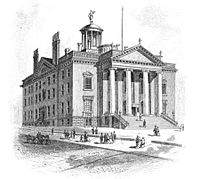45th New York State Legislature
| 45th New York State Legislature | |||||
|---|---|---|---|---|---|
|
|||||

The Old State Capitol (1879)
|
|||||
| Overview | |||||
| Jurisdiction | New York, United States | ||||
| Term | July 1, 1821 – December 31, 1822 | ||||
| Senate | |||||
| Members | 32 | ||||
| President | Lt. Gov. John Tayler (Clint.) | ||||
| Party control | Split (16-16) | ||||
| Assembly | |||||
| Members | 126 | ||||
| Speaker | Samuel B. Romaine (Buckt.) | ||||
| Party control | Bucktail (70-52) | ||||
| Sessions | |||||
|
|||||
| 1st | January 2 – April 17, 1822 |
|---|
The 45th New York State Legislature, consisting of the New York State Senate and the New York State Assembly, met from January 2 to April 17, 1822, during the fifth year of DeWitt Clinton's governorship, in Albany.
Under the provisions of the New York Constitution of 1777, amended by the Constitutional Convention of 1801, 32 Senators were elected on general tickets in the four senatorial districts for four-year terms. They were divided into four classes, and every year eight Senate seats came up for election. Assemblymen were elected countywide on general tickets to a one-year term, the whole Assembly being renewed annually.
In 1797, Albany was declared the State capital, and all subsequent Legislatures have been meeting there ever since. In 1818, the Legislature enacted that future Legislatures meet on the first Tuesday of January of each year unless called earlier by the governor.
State Senator Gideon Granger resigned in 1821, leaving a vacancy in the Western District.
On March 13, 1821, the 44th New York State Legislature passed a bill to submit the question, whether a Constitutional Convention should be called, to the voters at the next State election in April 1821.
In 1821, Erie County was split from Niagara County, but remained with Cattaraugus, Chautauqua and Niagara in one Assembly district. Livingston and Monroe counties were formed from parts of Genesee and Ontario counties, and were apportioned one seat each in the Assembly, taken from Ontario.
At this time the politicians were divided into two opposing political parties: the Federalists and the Democratic-Republicans. The Democratic-Republican Party was split into two factions: the Clintonians (supporters of Gov. DeWitt Clinton) and the Bucktails (led by Martin Van Buren, and including the Tammany Hall organization in New York City). The Federalist Party was disbanding, the majority joined the Clintonians, a minority joined the Bucktails.
...
Wikipedia
